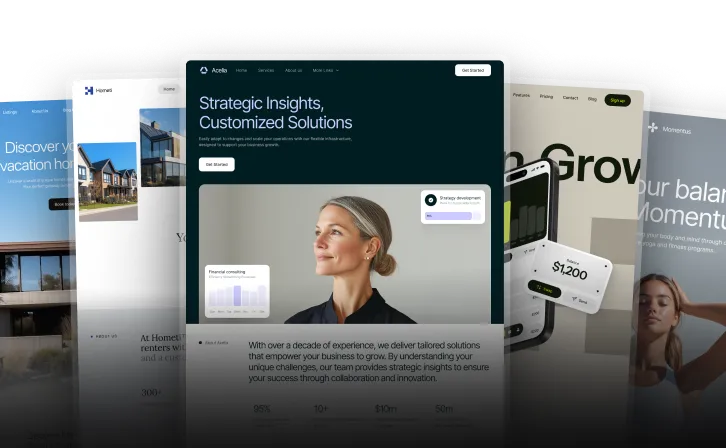Webflow Templates: The Definitive Handbook
Unlock all templates




Webflow templates simplify website building with pre-designed layouts, making them ideal for businesses and designers. They save time, require no advanced coding, and come with responsive designs, SEO-friendly structures, and built-in features. Here's what you need to know:
- What They Offer: Ready-made layouts, animations, and tools for various industries.
- Why They’re Useful: Faster site creation, professional results, and affordability.
- Template Categories: Portfolio, SaaS, Agency, E-commerce, Blog, Landing Page.
- How to Choose: Match your business needs with features like CMS, e-commerce, and customization options.
- Customization Tips: Adjust colors, fonts, and layouts to fit your brand using Webflow’s tools.
- Performance Tips: Optimize images, streamline code, and focus on mobile-first design for faster load times.
- SEO Setup: Use Webflow's built-in tools to improve rankings with meta tags, headings, and HTTPS.
Quick Comparison of Template Categories:
| Category | Best For | Features |
|---|---|---|
| Portfolio | Creatives | Galleries, project showcases |
| SaaS | Software companies | Feature highlights, pricing |
| Agency | Service businesses | Case studies, team profiles |
| E-commerce | Online stores | Shopping carts, product catalogs |
| Blog | Content creators | Article layouts, CMS integration |
| Landing Page | Marketing campaigns | Conversion-focused designs |
Start by selecting a template that aligns with your goals, customize it for your brand, and optimize performance for a polished, user-friendly website.
Webflow Template Tutorial | How to Customize a Webflow Template

How to Pick the Right Template
Selection Criteria
Picking the right Webflow template means focusing on what works best for your business. Think about your current needs and long-term goals. The right choice will save you time while keeping your site polished and professional.
Here’s what to look for:
| Criteria | What to Check | Why It Matters |
|---|---|---|
| Business Fit | Features tailored to your industry | Ensures the template meets your sector’s needs |
| Core Features | CMS, forms, e-commerce | Matches the tools your business requires |
| Customization | Style guide, blank pages | Helps align the design with your brand |
| Performance | Fast load speeds, mobile-friendly | Affects user experience and search rankings |
| Support | Documentation, tutorials | Makes setup and troubleshooting easier |
| Budget | $79–$129 for quality templates | Balances affordability with functionality |
Templates by Industry
Once you know what you need, look for templates that suit your specific industry.
For Technology & SaaS Companies:
- Miros ($129): Great for showcasing software products with customizable displays.
- Darken ($79): A sleek choice for tech startups with a modern touch.
- Dataluz ($79): Tailored for data-focused businesses.
For Financial Services:
- Moneta ($79): Perfect for accounting firms.
- Advisora ($129): Designed for financial consultants.
- Nicepay ($79): Ideal for fintech companies.
For Health & Wellness:
- Calmy ($79): Built for wellness centers.
- Harmoni ($79): A fit for fitness-focused businesses.
- Serenium ($79): Best for holistic health practices.
Template Features Checklist
Make sure your chosen template includes these must-have features:
Technical Requirements:
- Fully mobile-responsive and optimized for fast loading.
- Built with an SEO-friendly structure.
- Compatible with CMS for easier content management.
Design Elements:
- A style guide page to ensure branding consistency.
- Options for customizable colors and typography.
- Flexible layout designs to fit your needs.
Functionality:
- Integrated contact forms and social media links.
- Analytics tracking for performance insights.
- E-commerce capabilities if you plan to sell products or services.
Making Templates Your Own
Basic Changes
Start by tweaking the basics to align your template with your brand. With Webflow's Visual Editor, you can make live adjustments without needing to code. Here are a few key areas to focus on:
Brand Colors
Use Global Swatches to update your entire site's color palette in one step. This ensures consistent branding across all pages and elements. Plus, Webflow's contrast checker helps you meet accessibility standards by verifying text readability.
Typography Updates
Give your site some personality with thoughtful font choices:
- Access Google Fonts directly through Webflow.
- Upload custom fonts to make your branding stand out.
- Stick to a consistent heading hierarchy to improve SEO.
Layout Refinements
Fine-tune your layout for a polished, responsive design using Webflow's tools:
- Use percentage-based units instead of fixed pixels for flexible spacing.
- Rearrange sections to fit your content flow.
- Adjust padding and margins to ensure a smooth mobile experience.
Complex Modifications
Once you've nailed the basics, you can move on to advanced changes to fully customize your site. These adjustments let you build a high-performing, personalized website.
| Modification Type | Implementation Method | Key Considerations |
|---|---|---|
| Custom Features | Webflow's native tools | Ensure stability |
| Animations | Built-in effects | Optimize performance |
| External Tools | Third-party integration | Confirm compatibility |
| CMS Structure | Content organization | Maintain structure integrity |
Performance Optimization
Keep your site running smoothly by:
- Compressing images before uploading them.
- Keeping animations simple to avoid slowing down the site.
- Testing your design on various devices to ensure consistency.
Advanced Integration
For more complex needs, you can use specialized tools:
"Looking for hassle-free, creative, affordable fast support for your Webflow project? Our expert team covers it all." - FixFlow
Services like FixFlow provide professional customization starting at $2,280, making them a great option for businesses requiring extensive updates.
Accessibility Enhancements
Ensure your site is usable for everyone by:
- Adding descriptive alt text to images.
- Using proper heading structures for clarity.
- Including ARIA labels for interactive elements.
- Checking that your color contrast ratios meet accessibility guidelines.
sbb-itb-fdf3c56
Speed and Performance Tips
Making Sites Load Faster
Website speed plays a big role in user experience and conversion rates. Research shows that top-performing ecommerce sites load in under 2 seconds, while 26% of visitors leave if a site takes over 5 seconds to load.
Image Optimization
Improve your site's performance with these strategies:
| Optimization Type | Best Practice | Impact |
|---|---|---|
| Format Selection | Convert to WebP | Smaller file size, better quality |
| Vector Graphics | Use SVGs for logos | Crisp display at any size |
| Loading Strategy | Enable lazy loading | Faster initial page load |
Code and Script Management
Streamline your code and scripts:
-
Use
asyncordeferattributes for scripts that aren't needed immediately. - Delay script loading with tools like Google Tag Manager.
- Remove unused CSS and redundant code.
- Enable browser caching through Webflow's settings.
Once your site is running smoothly, it's time to focus on mobile users.
Mobile-First Design
With mobile traffic surpassing desktop usage, designing for smaller screens is more important than ever. Here's where you should focus:
Touch-Friendly Elements
Make your design mobile-friendly by:
- Setting button sizes to at least 44x44 pixels.
- Adding enough space between clickable elements.
- Using readable font sizes (16px or larger for body text).
"Mobile-first design isn't just a trend - it's a strategic approach to take on mobile-dominant markets." - Webflow Team
Mobile Performance Tips
For a smoother mobile experience:
- Use simplified navigation menus.
- Compress images, clean up code, and ensure clear navigation.
- Test regularly on different devices to catch any issues.
Search Engine Setup
A solid SEO setup helps your site rank higher on search engines. Webflow's built-in tools make this process easier.
Key SEO Elements
Don't skip these basics:
- Write meta descriptions between 120–160 characters.
- Create title tags (50–60 characters) with primary keywords.
- Use proper heading structures (H1–H6).
- Enable HTTPS for secure browsing (included with Webflow hosting).
Technical Optimization
Boost your site's technical SEO with these steps:
- Link your site to Google Search Console for monitoring.
- Generate and submit an XML sitemap.
- Set up 301 redirects when necessary.
- Add canonical tags to manage duplicate content effectively.
Help and Resources
Fix Common Problems
Here’s how to address some frequent template issues:
Image and Media Issues
Use tools like TinyPNG to compress images before uploading them. For videos, consider hosting them on platforms like YouTube or Vimeo to improve load times and overall performance.
Layout Problems
When creating responsive layouts, keep these tips in mind:
| Issue | Solution | Impact |
|---|---|---|
| Uneven Columns | Use div blocks with a grid layout instead of column elements | Allows for more responsive designs |
| Spacing Issues | Apply margins to the parent element, not individual children | Ensures consistent spacing across breakpoints |
| Mobile Menu | Test navigation on various devices | Improves the mobile user experience |
Template Customization
Organize your styles by giving descriptive names to classes (e.g., use hero-section instead of div-block-1). This keeps your design process streamlined and aligns with earlier tips for personalizing your templates.
If these fixes don’t fully solve your issues, consider diving deeper into the resources listed below.
Where to Learn More
Webflow University is packed with resources to help you learn. Their 21-day design portfolio course offers 4 hours and 51 minutes of structured content, making it a great option for both beginners and those with some experience.
Key Learning Resources
| Resource | Purpose | Best For |
|---|---|---|
| Webflow University | Courses and tutorials | Step-by-step learning |
| Community Forum | Peer support and discussions | Troubleshooting |
| Help Center | Quick answers and documentation | Resolving technical issues |
Main Benefits Review
Webflow templates provide clear advantages for both web designers and businesses. Here are three key benefits that make them stand out in modern web development:
| Benefit | Impact | Practical Advantage |
|---|---|---|
| Time Efficiency | Speeds up development by 50% | Pre-built layouts save you from starting from scratch |
| Professional Design | Access to 1,500+ templates | Created by experienced designers to serve as a reliable base |
| Full Customization | Total design flexibility | Adjust every element while ensuring the site stays responsive |
With these features, you can streamline your workflow and create high-quality websites faster.
Getting Started Steps
Here’s how to start using Webflow templates effectively:
Initial Setup
Choose a template that aligns with your business goals. Look for options that balance design quality with the flexibility you need for your project.
Customization Process
-
Brand Integration:
Update fonts and colors, replace placeholder content, and add your logo and other branding elements. -
Technical Optimization:
Optimize images to improve load times, test responsiveness on different devices, and configure SEO settings like meta tags. -
Final Preparations:
Connect analytics tools, check site interactivity across devices, and ensure compatibility with multiple browsers.
Take advantage of Webflow’s built-in tools and community resources to get the most out of your template. The platform’s extensive library and flexible features make it easy to build a polished, professional website.
Related Blog Posts
Recommended posts
Unlock all templates







